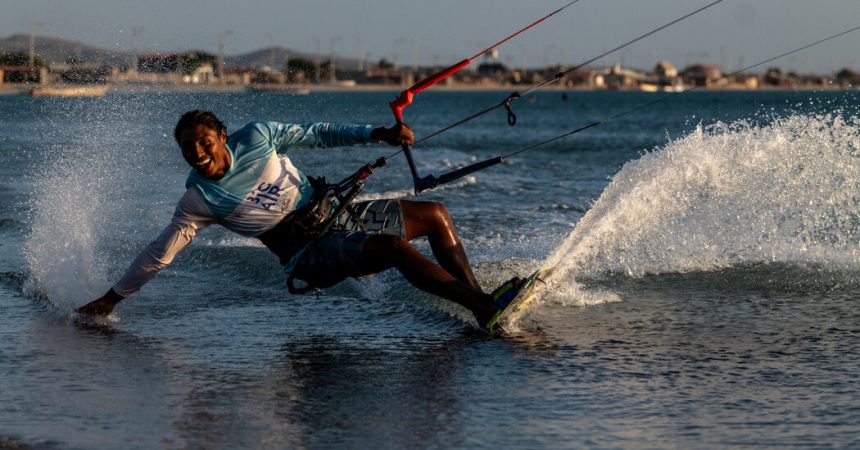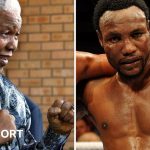They came from all over the world to this remote stretch of Colombia’s Caribbean coast. Two hailed from India. Two traveled from Switzerland. One from the Netherlands. Another from Seattle. They all wanted to be taught by Beto Gomez, a professional kite surfer, in the spot where he first learned the sport.
La Guajira Peninsula is ideal for kite surfing. In Cabo de la Vela, Mr. Gomez’s hometown, with nearly 1,000 residents and desert terrain, the windy season lasts nine months and the waves are flat.
So for five days this year, amateur kite surfers — drawn by Mr. Gomez’s social media and competitions broadcast online — traveled here for his classes.
“In India, we were really cheering for him,” said Shyam Rao, 33, who arrived with his wife.
Kite surfing, using a kite to propel a rider across the water and through the air, is not native to this part of the world or to the Wayuu, Colombia’s largest Indigenous group, which governs the area.
It was brought to Cabo de la Vela nearly two decades ago by visiting foreigners or arijuna, a term in the Wayuu Indigenous language that includes Colombians who aren’t Wayuu.
Not everyone in the community, whose leaders have fought to preserve their land and traditions, has embraced a sport that has brought growth and change.
But kite surfing has undoubtedly turned Cabo de la Vela into a budding destination. Mr. Gomez’s family found a source of income beyond the usual fishing or artisan crafts in one of Colombia’s poorest and most malnourished regions. And Mr. Gomez, 24, earned a ticket out, becoming the world’s only professional Wayuu kite surfer.
“Kite surfing has been a gift for us because it opened the door for our town; it allowed me to leave and to fly all over the world,” Mr. Gomez said, at the kite surfing school he owns with his older brother. “I want others here to do the same.”
Mr. Gomez was 7 the first time he saw kite surfing.He watched in awe as visiting kite surfers soared through the air.
“We had that emotion of, ‘Wow, something new came and we want to learn it,’” he said. But he realized “that we were never going to learn it because that’s not for us. ”
Back then, Cabo de la Vela was much smaller, said Margarita Epieyu, Mr. Gomez’s mother, made up of roughly six extended families, which is how Wayuu communities are organized.
Tour buses arrived maybe every other month, only for quick trips to the beach, Mr. Gomez said.
To get by, his father delivered water, his mother sold traditional Wayuu bags and hammocks, and he hawked bracelets. His family often ate one meal a day, usually fish donated by the community’s fishermen.
“There was no tourism,” Ms. Epieyu, 49, said, “so here there weren’t jobs.”
But that began changing in 2009, when Martin Vega, a Colombian kite surfing instructor, brought students from a kite surfing school near Barranquilla. “The wind was perfect,” he said.
Mr. Vega, along with a friend, soon decided to stay; they established the town’s first kite surfing school on land owned by a local Wayuu resident.
One day, he said, a boy intrigued by visiting kite surfers raced after his car. It was Mr. Gomez’s older brother Nelson, who already earned tips helping tourists and learned the basics of navigating on the water.
Mr. Vega soon met Beto Gomez, who was then 10. Under Mr. Vega’s watch and with their mother’s permission, the boys trained after school and on weekends — if their homework and chores were done.
“We were like fish,” Nelson Gomez, 25, said. “We could go in at 9 a.m. and leave at 6 p.m.”
Added Mr. Vega, 41, “The idea was for locals to help us and come and learn, and that’s what happened.”
Nelson Gomez was a natural talent, but his competitive career ended when his leg was seriously injured in 2017, while he trained in Brazil. Beto Gomez, though, developed his abilities. At 13, he finished second in his first competition — a regional one three hours away.
“That was my first connection to the world, with a city, with escalators, elevators, traffic lights,” said Mr. Gomez, who learned English from tourists.
Three years later, Mr. Gomez won his first competition, and in 2017, relying on donations, he left Colombia for the first time, to compete in the Dominican Republic.
Every time he left, he said, the Wayuu authority, the group of elders who run Cabo de la Vela, had to grant permission, because the rule was “we cannot have contact with the outside world.”
But when he was 18 and competing in Brazil, the Wayuu elders denied his request to stay and work as a kite surfing instructor. He did anyway.
As punishment, he said he was told to stay away for two years.
His mother, who had married young and later divorced Mr. Gomez’s father, said she defended her son and encouraged her children to pursue “opportunities I didn’t have.”
His mother, Mr. Gomez said, “always wanted us to follow our dreams and to go and live away from here.” She also urged them to go to college and date people who were not Wayuu.
He followed her advice, moving to Argentina in 2020 after a competition there and falling in love with an Argentine woman. This past March, his mother, who had never flown before, took off with him from Bogotá for a visit to his home in Argentina.
As kite surfing grew in Cabo de la Vela, more tourists, restaurants, hostels and money arrived. Some Wayuu have welcomed the changes, but others are wary.
“Here in Cabo, the negative has been very minimal,” said Edwin Salgado, 29, who owns a kite surfing school. “It’s not a massive tourism, and the Wayuu culture is still felt and represented.”
Ms. Epieyu, who receives money every month from her son’s professional earnings, said seven of her 10 children now kite surf.
“Even though people may not want it, kite surfing has changed Cabo,” she said.
But some residents said more visitors has meant more alcohol, drugs, parties and outside influence.
The Wayuu consider Cabo de le Vela to be on sacred ground because, they believe, souls come to rest there and if they allow outsiders to “invade,” they will “end up without our territory,” said Elba Gomez, 73, Beto’s paternal aunt and a member of the Wayuu authority.
Citing “disorder” and people “not friendly to their culture and territory,” the Wayuu authority, in a 2018 crackdown, pushed out foreign owners of businesses because it believed those should be operated by Wayuu people.
Mr. Vega was one of two foreign owners of kite surfing schools. (Four schools remain today.) He sold the school to the Gomez brothers, and he and his wife moved to Riohacha, a city three hours away. There, he said, it was easier to raise their first child and start a new school nearby.
“I obviously respect the community, its customs and rules,” Mr. Gomez said. “It’ll change at some point, and I want to be part of that process, because this changed my life.”
Every winter, Mr. Gomez returns home to Cabo de la Vela to visit family, give local children free kite surfing lessons and host a paid camp.
For paying guests, Mr. Gomez’s mother recently made a dinner of grilled goat and arepas.
The family wore traditional outfits, Mr. Gomez and his sisters performed a dance around a bonfire and explained their culture and language. Whether he is in Argentina or competing around the world, Mr. Gomez said he will always trumpet his Wayuu roots.
“I want to promote Cabo a little more so people come visit and enjoy our culture,” he said, “not to change us and do what is always done everywhere, colonize.”







